The Influence of Proximity on the Evolution of Urban Innovation Networks in Nanjing Metropolitan Area, China: A Comparative Analysis of Knowledge and Technological Innovations
Abstract
:1. Introduction
2. Literature Review
2.1. The Relationship between Metropolitan Areas and Urban Innovation
2.2. Studies on Metropolitan Areas and Their Innovation Systems in China
2.3. Studies on Metropolitan Areas and Innovation Networks in China
2.4. The Essence of Innovation Network Research in Metropolitan Areas
- (1)
- What type of network has emerged among the cities in the NMA through collaborative efforts in knowledge and technological innovation? What are its structural properties and evolutionary patterns?
- (2)
- Which proximity dynamics can account for the emergence of the urban innovation network within the NMA?
- (3)
- How do varying proximity factors influence the development of the urban innovation network in the NMA, and how do their effects differ between knowledge and technological innovation?
3. Materials and Methods
3.1. Study Area
3.2. Data Description and Sources
3.3. Research Methods and Procedures
3.4. Selection and Measurement of Variables for Factors Influencing Proximity
- Geographical (Geo) Proximity. Existing research demonstrates that knowledge and technology dissemination diminishes with distance; thus, geographical proximity plays a pivotal role in enhancing innovation linkages by mitigating information exchange barriers and reducing transportation costs [46]. Proximity in geographic terms fosters communication and interaction among innovators, thereby facilitating the spillover of tacit knowledge, which is crucial for R&D collaboration [49]. Moreover, in urban innovation networks, geographical proximity can indirectly foster the emergence and growth of other forms of proximity [50]. Following the methodology of Hong and Su [51], this study computes the spherical distance between cities using their latitude and longitude data, employing the Geopy library in Python;
- Organizational (Org) Proximity. Research utilizing Chinese datasets has revealed that collaborative entities tend to cluster at the municipal level, with organizational proximity manifesting through the administrative boundaries of provincial institutions in China [36]. There is a higher propensity for cities within the same province to collaborate. Consequently, this study assigns a value of 1 to cities located within the same province and a value of 0 to those that are not;
- Social (Soc) Proximity. The assessment of social proximity derives from the dialectal regions to which cities are affiliated. Drawing on the studies of Zhang et al. [42] and the classification criteria set forth in “Chinese Cultural Geography” [52], the nine cities within the NMA are categorized into two dialectal regions. Cities sharing the same dialectal region receive a score of 1, while those from different regions are assigned a score of 0;
- Institutional (Ins) Proximity. Generally, Innovation agents typically prefer to forge positive, cooperative relationships within similar institutional frameworks, exemplified by a city’s degree of marketization. Highly marketized cities not only exhibit increased enthusiasm from these agents but also promote the flow of innovative talent and resources, thereby strengthening inter-city innovation linkages. This study utilizes the “China Marketization Index” [53] to evaluate marketization structure congruity across cities, drawing on past research and data spanning several years [54];
- Cognitive (Cog) Proximity. This concept pertains to the similarity in knowledge among cities, with closer cognitive proximity indicating a higher likelihood of forging cooperative links [55]. Given that such collaboration occurs within innovative urban networks, the disparity in city innovation indices serves as a measure of cognitive proximity in terms of innovative knowledge. The city innovation index is derived from the “China City and Industry Innovation Capability Report 2017” [56]. It is calculated using a patent value model that takes into account patent duration [57], a method that is both highly objective and recognized for effectively assessing patent value and innovation capacity;
- Technological (Tec) Proximity. It refers to the extent of similarity in the technological foundations and knowledge infrastructures of the two cities. An optimal level of technological distance fosters effective knowledge transfer between collaborators, catalyzing the emergence of novel technologies and methodologies. In this study, we utilize the congruence of patent portfolios across cities as an indicator of technological proximity, drawing on the seminal work of Jaffe [58].
4. Results and Discussion
4.1. Evolutionary Dynamics of the NMA Innovation Network
4.1.1. Evolutionary Dynamics in Urban KIN
4.1.2. Evolutionary Dynamics in Urban TIN
4.2. Comparison of Urban Knowledge and Technological Innovation Network
4.3. Proximity Mechanisms of Innovation Collaboration in the NMA
4.4. Limitations and Prospects
5. Conclusions and Recommendations
5.1. Conclusions
5.2. Recommendations
Author Contributions
Funding
Data Availability Statement
Conflicts of Interest
References
- Huggins, R. Competitiveness and the Global Region: The Role of Networking Innovation Networks and Learning Regions; Jessica Kingsley Publishers: London, UK, 1997. [Google Scholar]
- Diez, J.R. Metropolitan Innovation Systems: A Comparison between Barcelona, Stockholm, and Vienna. Int. Reg. Sci. Rev. 2002, 25, 63–85. [Google Scholar] [CrossRef]
- Castells, M. The Rise of the Network Society; Blackwell: Oxford, UK, 1996. [Google Scholar]
- Gottmann, J. Megalopolis or the Urbanization of the Northeastern Seaboard. Econ. Geogr. 1957, 33, 189. [Google Scholar] [CrossRef]
- Vicino, T.J.; Hanlon, B.; Short, J.R. Megalopolis 50 Years On: The Transformation of a City Region. Int. J. Urban Reg. Res. 2007, 31, 344–367. [Google Scholar] [CrossRef]
- Lang, R.; Knox, P.K. The New Metropolis: Rethinking Megalopolis. Reg. Stud. 2009, 43, 789–802. [Google Scholar] [CrossRef]
- Li, Y. A Preliminary Analysis on Urban Innovation Network of Metropolitan Region and its Characteristics. City Plan. Rev. 2019, 43, 27–33+39. (In Chinese) [Google Scholar]
- Gottmann, J. Megalopolis Revisited: 25 Years Later; University of Maryland Urban Studies: College Park, MD, USA, 1987. [Google Scholar]
- Taylor, P.J.; Catalano, G.; Walker, D.R.F. Measurement of the World City Network. Urban Stud. 2002, 39, 2367–2376. [Google Scholar] [CrossRef]
- Fischer, M.M.; Diez, J.R.; Snickars, F. Metropolitan Innovation Systems: Theory and Evidence from Three Metropolitan Regions in Europe; Springer Science & Business Media: Berlin/Heidelberg, Germany, 2001. [Google Scholar]
- Bettencourt, L.M.A.; Lobo, J.; Strumsky, D. Invention in the city: Increasing returns to patenting as a scaling function of metropolitan size. Res. Policy 2007, 36, 107–120. [Google Scholar] [CrossRef]
- Li, Y.; Phelps, N. Megalopolis unbound: Knowledge collaboration and functional polycentricity within and beyond the Yangtze River Delta Region in China. Urban Stud. 2018, 55, 443–460. [Google Scholar] [CrossRef]
- Yu, H.; Ning, Y. Introduction to Urban Geography; Anhui Science and Technology Press: Hefei, China, 1983. [Google Scholar]
- Dong, L. Initial thoughts of China’s Urbanization; Chinese Construction Industry Press: Beijing, China, 1989. [Google Scholar]
- Fang, C.; Yu, D. Urban agglomeration: An evolving concept of an emerging phenomenon. Landsc. Urban Plan. 2017, 162, 126–136. [Google Scholar] [CrossRef]
- Zhang, Y.; Li, H. Innovation search of new ventures in a technology cluster: The role of ties with service intermediaries. Strateg. Manag. J. 2010, 31, 88–109. [Google Scholar] [CrossRef]
- Fu, W.; Revilla Diez, J.; Schiller, D. Interactive learning, informal networks and innovation: Evidence from electronics firm survey in the Pearl River Delta. China Res. Policy 2013, 42, 635–646. [Google Scholar] [CrossRef]
- Chen, J.; Jiang, L.; Tian, Y.; Luo, J. The Study of Regional Innovation Network Structure: Evidence from the Yangtze River Delta Urban Agglomeration. ISPRS Int. J. Geo-Inf. 2023, 12, 428. [Google Scholar] [CrossRef]
- Liang, L.; Wang, Z.; Li, J. The effect of urbanization on environmental pollution in rapidly developing urban agglomerations. J. Clean. Prod. 2019, 237, 117649. [Google Scholar] [CrossRef]
- Macioszek, E.; Jurdana, I. Transport of Goods on the Example of a Selected Section of Transport in Poland. Sci. J. Silesian Univ. Technol. Ser. Transp. 2023, 121, 127–140. [Google Scholar] [CrossRef]
- Zhang, Q.; Su, S. Determinants of urban expansion and their relative importance: A comparative analysis of 30 major metropolitans in China. Habitat Int. 2016, 58, 89–107. [Google Scholar] [CrossRef]
- Wang, Y.; Wang, C.; Mao, X.; Liu, B.; Zhang, Z.; Jiang, S. Spatial Pattern and Benefit Allocation in Regional Collaborative Innovation of the Yangtze River Delta, China. Chin. Geogr. Sci. 2021, 31, 900–914. [Google Scholar] [CrossRef]
- Wang, X. Preliminary study on the basic characteristics and develoment mechanism of innovative metropolitan area. Nanjing J. Soc. Sci. 2014, 9–16. (In Chinese) [Google Scholar] [CrossRef]
- Wang, X.; Zhu, K. Innovative space of metropolitan area: Types, patterns and evolution: The caseof Nanjing metropolitan area. Urban Dev. Stud. 2015, 22, 8–15. (In Chinese) [Google Scholar]
- Zhan, X.; Wang, B. A study on knowledge ecology and metropolitan innovation system: The review based on literature. Stud. Sci. Sci. 2014, 32, 1909–1920. (In Chinese) [Google Scholar]
- Wang, X.; Feng, M.; Gu, H. A study discriminative characteristics of intercity innovation linkage at different scales: A case study of Yangtze River Delta. J. Southeast Univ. Philos. Soc. Sci. 2015, 17, 108–116+148. (In Chinese) [Google Scholar]
- Shen, M.; Wang, Z.; Cui, G. Planning metropolitan regions in China: Theoretical originsand planning practices. Urban Plan. Forum 2023, 2023, 57–66. (In Chinese) [Google Scholar]
- Bathelt, H.; Malmberg, A.; Maskell, P. Clusters and knowledge: Local buzz, global pipelines and the process of knowledge creation. Prog. Hum. Geogr. 2004, 28, 31–56. [Google Scholar] [CrossRef]
- Karlsson, C.; Johansson, B.; Stough, R. Entrepreneurship and Dynamics in the Knowledge Economy; Routledge: London, UK, 2006; Volume 25. [Google Scholar]
- Ma, H.; Li, Y.; Huang, X. Proximity and the evolving knowledge polycentricity of megalopolitan science: Evidence from China’s Guangdong-Hong Kong-Macao Greater Bay Area, 1990–2016. Urban Stud. 2021, 58, 2405–2423. [Google Scholar] [CrossRef]
- Lu, T.; Wu, Z.; Huang, L. Network relations and spatial organization: A comparative analysis of innovative cooperation relations between the Yangtze River Delta and northeastern U. S. city groups. Urban Plan. Forum 2016, 31, 51–60. (In Chinese) [Google Scholar]
- Jiao, M.; Du, D.; Gui, Q.; Hou, C. The spatio-temporal evolution and influencing factors of urban technical corporation networks: From the perspective of Belt and Road. Geogr. Res. 2021, 40, 913–927. (In Chinese) [Google Scholar]
- Xi, Q.; Li, G.; Sun, Y.; Lyu, S. Evolutionary characteristics of science and technology cooperation network of Beijing-Tianjin-Hebei region and its influencing factors. Acta Geogr. Sin. 2022, 77, 1359–1373. (In Chinese) [Google Scholar]
- Zhang, J.G.; Wang, H. The holist transforation implied in the San Francisco Bay Areaplanning: With discussion on Chinese metropolitan area planning. Urban Plan. Int. 2022, 37, 114–121. (In Chinese) [Google Scholar]
- Yin, Z.; Yuan, X.; Lu, Q.; Lin, P.; Wang, Q. China Metropolitan Area Development Report; Tsinghua University Press: Beijing, China, 2019. (In Chinese) [Google Scholar]
- Li, Y.; Phelps, N. Knowledge polycentricity and the evolving Yangtze River Delta megalopolis. Reg. Stud. 2017, 51, 1035–1047. [Google Scholar] [CrossRef]
- Hagedoorn, J.; Cloodt, M. Measuring innovative performance: Is there an advantage in using multiple indicators? Res. Policy 2003, 32, 1365–1379. [Google Scholar] [CrossRef]
- Huallachain, B.Ó.; Lee, D.S. Urban centers and networks of coinvention in American biotechnology. Ann. Reg. Sci. 2014, 52, 799–823.1. [Google Scholar] [CrossRef]
- Sun, Y.; Lu, Y.; Wang, T.; Ma, H.; He, G. Pattern of patent-based environmental technology innovation in China. Technol. Forecast. Soc. Chang. 2008, 75, 1032–1042. [Google Scholar] [CrossRef]
- Yan, Y.; Wang, X. Global Contraction and Local Strengthening of Firms’ Supply and Sales Logistics Networks in the Context of COVID-19: Evidence from the Development Zones in Weifang, China. ISPRS Int. J. Geo-Inf. 2021, 10, 477. [Google Scholar] [CrossRef]
- Broekel, T.; Balland, P.-A.; Burger, M.; van Oort, F. Modeling knowledge networks in economic geography: A discussion of four methods. Ann. Reg. Sci. 2014, 53, 423–452. [Google Scholar] [CrossRef]
- Zhang, W.; Derudder, B.; Wang, J.; Witlox, F. An analysis of the determinants of the multiplex urban networks in the Yangtze River Delta. Tijdschr. Voor Econ. En Soc. Geogr. 2020, 111, 117–133. [Google Scholar] [CrossRef]
- Shaw, A.T.; Gilly, J.-P. On the Analytical Dimension of Proximity Dynamics. Reg. Stud. 2000, 34, 169–180. [Google Scholar] [CrossRef]
- Torre, A.; Rallet, A. Proximity and localization, Reg. Stud. 2005, 39, 47–59. [Google Scholar] [CrossRef]
- Kirat, T.; Lung, Y. Innovation and proximity: Territories as loci of collective learning processes. Eur. Urban Reg. Stud. 1999, 6, 27–38. [Google Scholar] [CrossRef]
- Boschma, R. Proximity and innovation: A critical assessment. Reg. Stud. 2005, 39, 61–74. [Google Scholar] [CrossRef]
- Knoben, J.; Oerlemans, L.A.G. Proximity and inter-organizational collaboration: A literature review. Int. J. Manag. Rev. 2006, 8, 71–89. [Google Scholar] [CrossRef]
- Liu, Y.; Shao, X.; Tang, M.; Lan, H. Spatio-temporal evolution of green innovation network and its multidimensional proximity analysis: Empirical evidence from China. J. Clean. Prod. 2021, 283, 124649. [Google Scholar] [CrossRef]
- Hoekman, J.; Frenken, K.; Tijssen, R.J.W. Research collaboration at a distance: Changing spatial patterns of scientific collaboration within Europe. Res. Policy 2010, 39, 662–673. [Google Scholar] [CrossRef]
- Balland, P.A.; Boschma, R.; Frenken, K. Proximity and innovation: From statics to dynamics. Reg. Stud. 2015, 49, 907–920. [Google Scholar] [CrossRef]
- Hong, W.; Su, Y.S. The effect of institutional proximity in non local university-industry collaborations: An analysis based on Chinese patent data. Res. Policy 2013, 42, 454–464. [Google Scholar] [CrossRef]
- Wang, E.; Hu, Z.; Zhou, S.; Hao, W.; Liu, Y. Chinese Cultural Geography; Science Press: Beijing, China, 2008. (In Chinese) [Google Scholar]
- Fan, G.; Wang, X.; Zhu, H. Indexes on Chinese Marketization; Economic Science Press: Beijing, China, 2011. (In Chinese) [Google Scholar]
- Liu, F.; Nan, D. The impact of geographical proximity on enterprise innovation performance. Stud. Sci. Sci. 2018, 36, 1708–1715. (In Chinese) [Google Scholar]
- Frenken, K.; Van Oort, F.; Verburg, T. Related variety, unrelated variety and regional economic growth. Reg. Stud. 2007, 41, 685–697. [Google Scholar] [CrossRef]
- Kou, Z.; Liu, X. FIND Report on City and Industrial Innovation in China (2017); Fudan Institute of Industrial Development, School of Economics, Fudan University: Shanghai, China, 2017. (In Chinese) [Google Scholar]
- Lanjouw, J.O. Patent protection in the shadow of infringement: Simulation estimations of patent value. Rev. Econ. Stud. 1998, 65, 671–710. [Google Scholar] [CrossRef]
- Jaffe, A.B. Demand and supply influences in R&D intensity and productivity growth. Rev. Econ. Stat. 1988, 70, 431–437. [Google Scholar] [CrossRef]
- Scherngell, T.; Hu, Y. Collaborative knowledge production in China: Regional evidence from a gravity model approach. Reg. Stud. 2011, 45, 755–772. [Google Scholar] [CrossRef]
- Wang, Q.; Hu, Z. Urban Innovation network of Zhejiang from the perspective of multidimensional proximities. Sci. Geogr. Sin. 2021, 41, 1380–1388. (In Chinese) [Google Scholar]
- Dai, L.; Liu, C.; Wang, S.; Ji, Y.; Ding, Z. Proximity and self-organizing mechanisms underlying scientific collaboration of cities in the Yangtze River Delta. Geogr. Res. 2022, 41, 2499–2515. (In Chinese) [Google Scholar]
- Wang, H.; Sun, Q.; Guo, J.; Du, M. Research on evolution dynamic of collaborative innovation network in the urban agglomeration of Yangtze River Delta based on ERGM. Sci. Technol. Prog. Policy 2021, 38, 45–53. (In Chinese) [Google Scholar]
- Cao, Z.; Derudder, B.; Peng, Z. Interaction between different forms of proximity in inter-organizational scientific collaboration: The case of medical sciences research network in the Yangtze River Delta region. Pap. Reg. Sci. 2019, 98, 1903–1924. [Google Scholar] [CrossRef]
- Fang, C. Important progress and future direction of studies on China’s urban agglomerations. J. Geogr. Sci. 2015, 25, 1003–1024. [Google Scholar] [CrossRef]
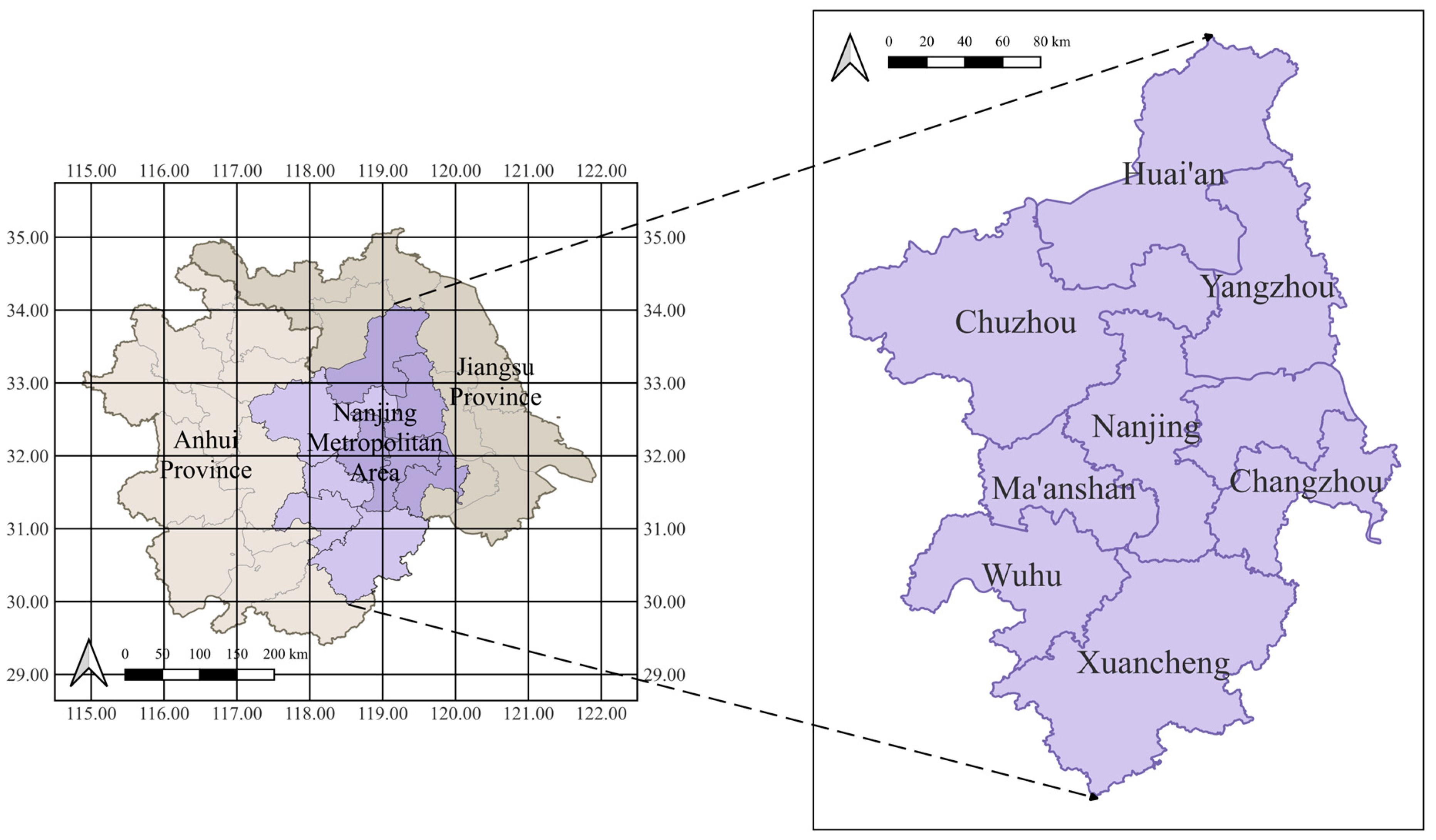

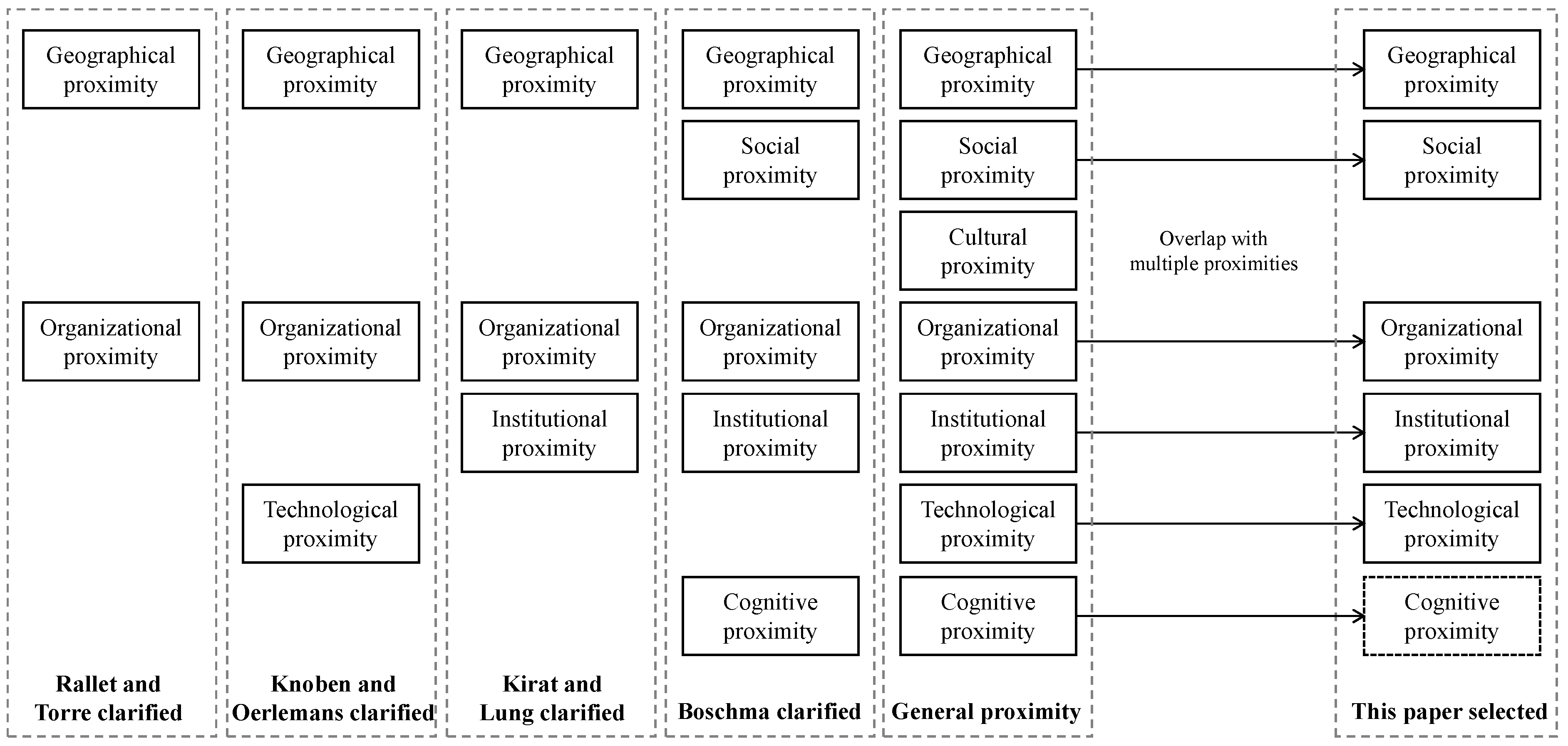
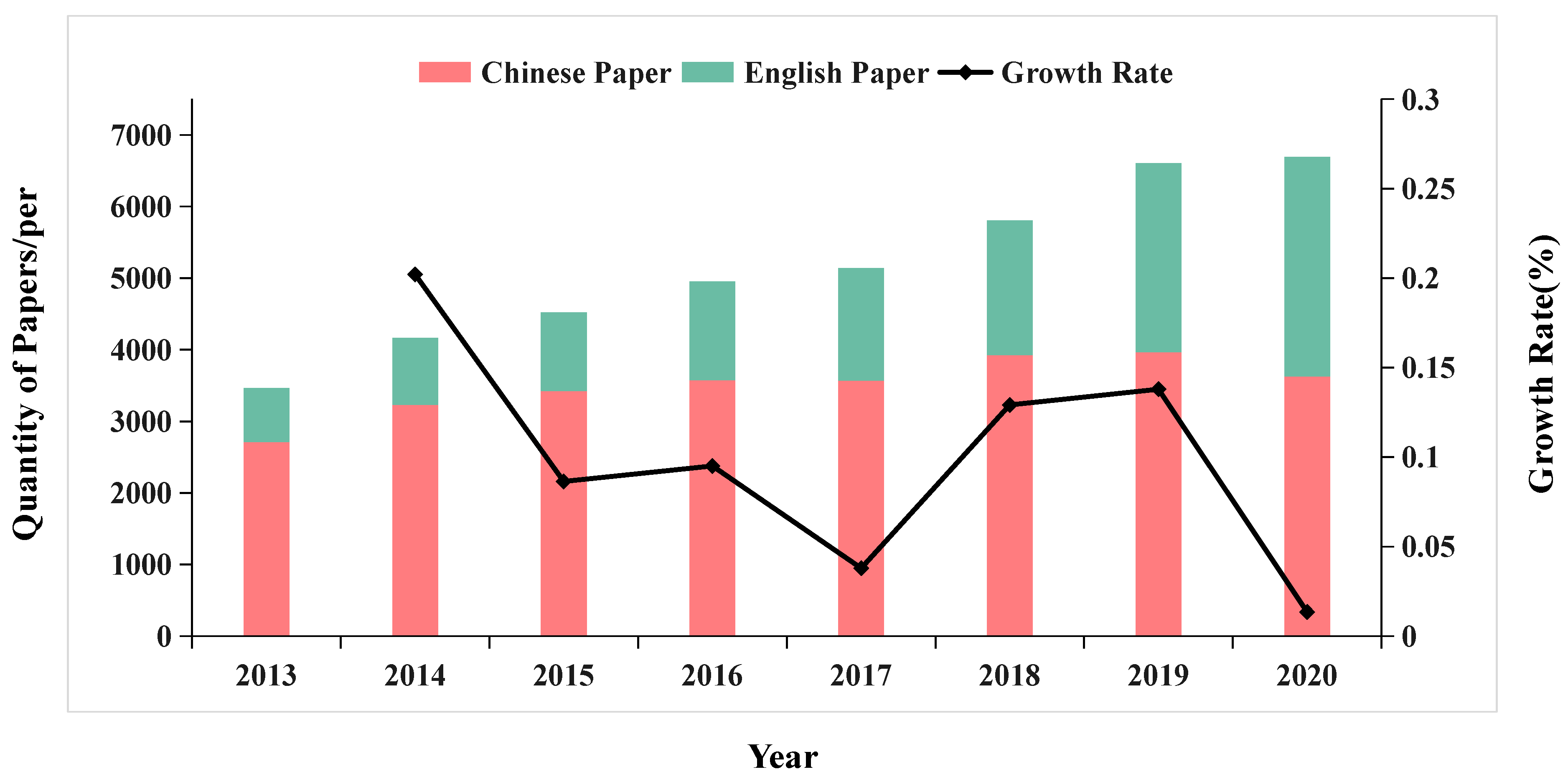
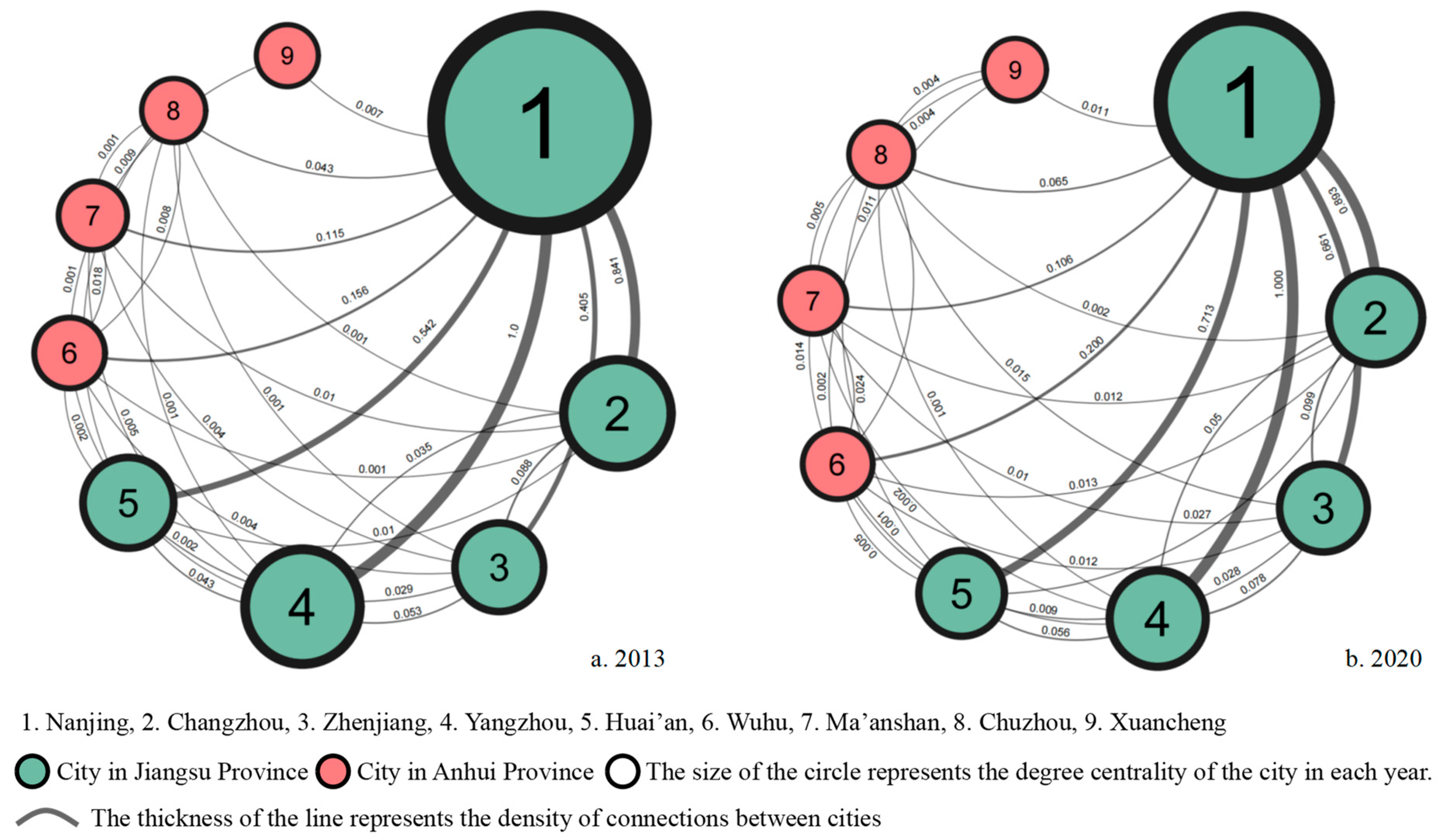
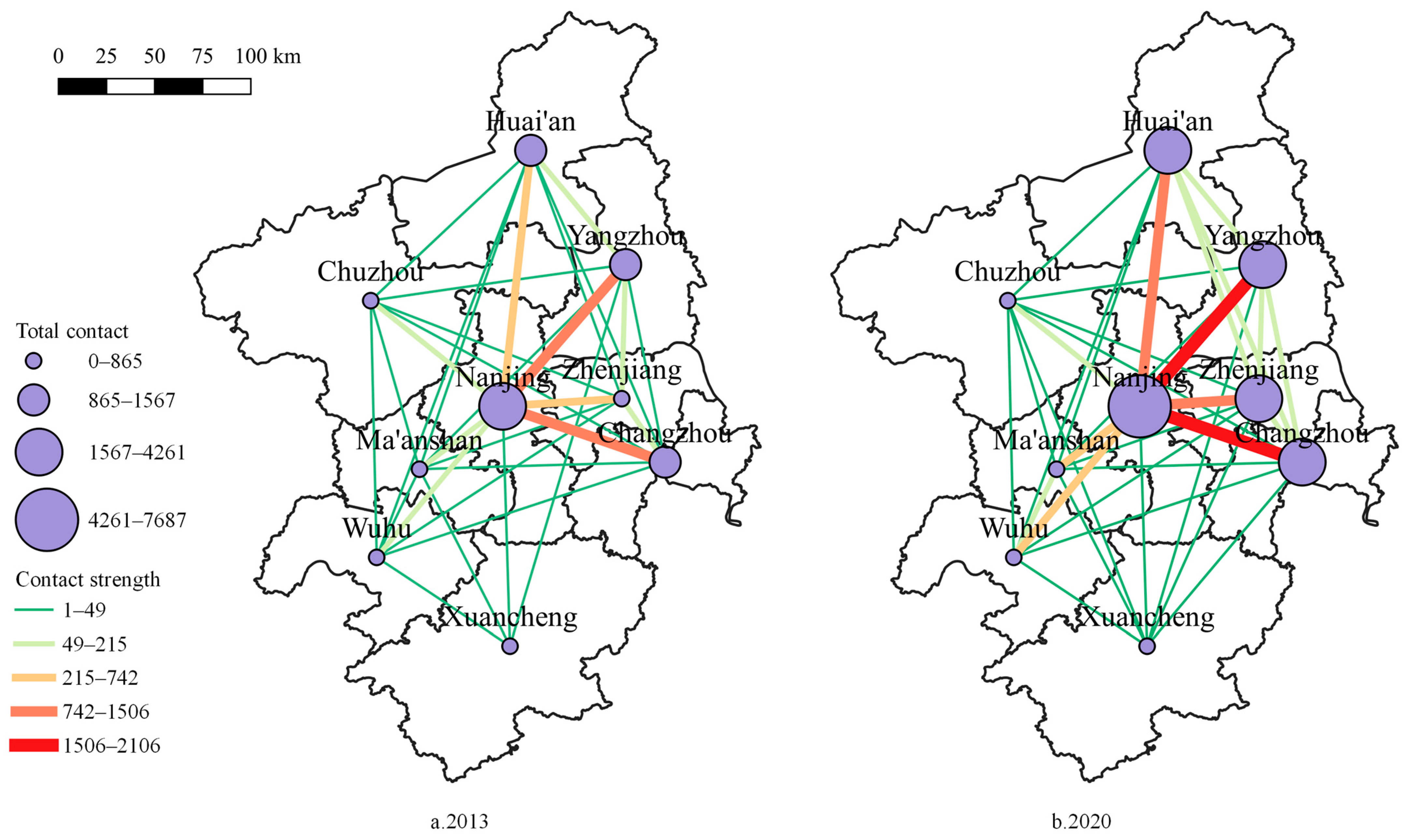
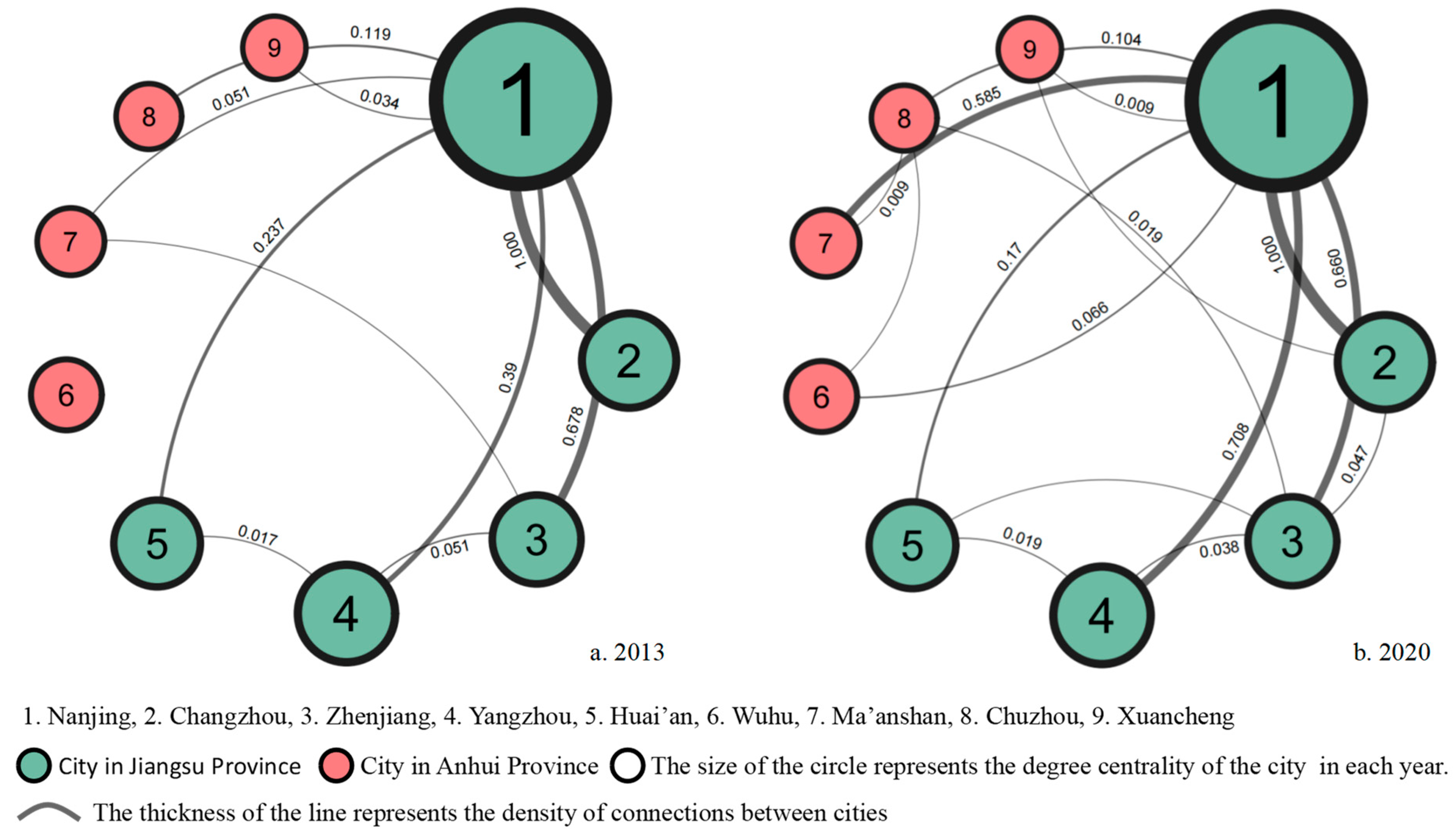
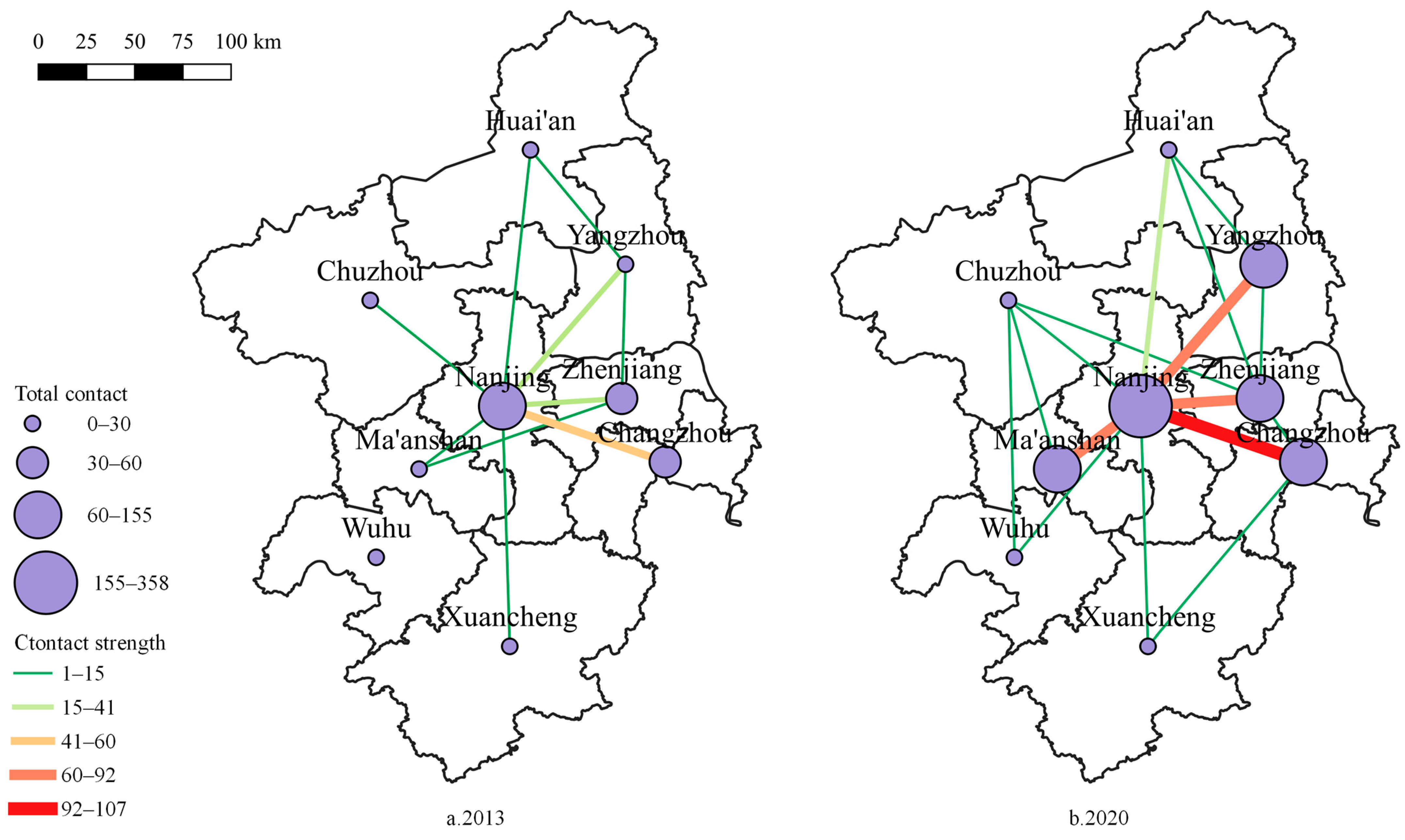

| Indicator | Calculation Formula | Formula Explanation | Meaning of Indicator |
|---|---|---|---|
| Degree Centrality | Total number of connections of node i with other nodes. | The significance of nodes within a network | |
| Network Density | The proportion of existing connections among network nodes relative to the maximum potential connections. | Tightness of the network | |
| Average Clustering Coefficient | The average ratio of the actual number of edges linking nodes within the network to the maximum feasible number of edges. | Describes the degree to which nodes in the entire network are clustered into small groups | |
| Average Path Length | The mean length of the shortest paths connecting all pairs of nodes in the network. | Measures the connectivity of the network |
| Year | Number of Relationships | Network Density | Average Clustering Coefficient | Average Path Length |
|---|---|---|---|---|
| 2013 | 32 | 0.889 | 0.937 | 1.111 |
| 2014 | 33 | 0.917 | 0.940 | 1.083 |
| 2015 | 31 | 0.861 | 0.909 | 1.139 |
| 2016 | 32 | 0.889 | 0.937 | 1.111 |
| 2017 | 31 | 0.861 | 0.878 | 1.139 |
| 2018 | 35 | 0.972 | 0.972 | 1.028 |
| 2019 | 35 | 0.972 | 0.972 | 1.028 |
| 2020 | 35 | 0.972 | 0.972 | 1.028 |
| Year | Number of Relationships | Network Density | Average Clustering Coefficient | Average Path Length |
|---|---|---|---|---|
| 2013 | 10 | 0.357 | 0.695 | 1.643 |
| 2014 | 12 | 0.429 | 0.801 | 1.571 |
| 2015 | 10 | 0.357 | 0.695 | 1.643 |
| 2016 | 12 | 0.333 | 0.643 | 1.833 |
| 2017 | 14 | 0.389 | 0.650 | 1.611 |
| 2018 | 14 | 0.500 | 0.846 | 1.500 |
| 2019 | 15 | 0.417 | 0.665 | 1.583 |
| 2020 | 16 | 0.444 | 0.772 | 1.556 |
| Type of Collaboration | NMA | Nanjing–Changzhou | Nanjing–Yangzhou | Nanjing–Zhenjiang |
|---|---|---|---|---|
| Company to Company | 67.10% | 85.48% | 59.12% | 53.17% |
| University to University | 1.85% | 0.30% | 1.95% | 1.75% |
| Research Institution to Research Institution | 0.69% | 2.12% | 0 | 0.22% |
| Company to University | 20.71% | 5.75% | 27.25% | 33.70% |
| Company to Research Institution | 5.86% | 6.20% | 9.00% | 5.25% |
| University to Research Institution | 3.79% | 0.15% | 2.68% | 5.91% |
| City | Percentage of Co-Published Papers | Percentage of Collaborative Patents | ||
|---|---|---|---|---|
| 2013 | 2020 | 2013 | 2020 | |
| Nanjing | 45.02% | 44.44% | 48.61% | 47.11% |
| Changzhou | 14.33% | 13.38% | 24.56% | 15.00% |
| Zhenjiang | 8.51% | 11.04% | 11.65% | 11.32% |
| Yangzhou | 16.56% | 14.60% | 7.59% | 11.05% |
| Huai’an | 9.14% | 10.16% | 4.30% | 3.03% |
| Ma’anshan | 2.29% | 1.06% | 1.27% | 8.55% |
| Chuzhou | 0.89% | 1.36% | 2.03% | 2.37% |
| Wuhu | 2.99% | 3.54% | 0.00% | 1.18% |
| Xuancheng | 0.27% | 0.40% | 0.00% | 0.39% |
| Variable | 2013 | 2020 | ||||||
|---|---|---|---|---|---|---|---|---|
| Paper | Patent | Paper | Patent | |||||
| Stdized Coefficient | Significance | Stdized Coefficient | Significance | Stdized Coefficient | Significance | Stdized Coefficient | Significance | |
| Geo | 0.067 | 0.282 | −0.038 | 0.396 | 0.033 | 0.341 | −0.13 | 0.175 |
| Org | 0.360 | 0.005 *** | 0.280 | 0.047 ** | 0.351 | 0.016 ** | 0.19 | 0.12 |
| Soc | −0.080 | 0.180 | −0.125 | 0.064 * | −0.077 | 0.003 *** | −0.096 | 0.038 ** |
| Ins | −0.075 | 0.316 | −0.043 | 0.403 | −0.042 | 0.402 | 0.030 | 0.427 |
| Cog | 0.693 | 0.003 *** | 0.627 | 0.018 ** | 0.643 | 0.001 *** | 0.620 | 0.004 *** |
| Tec | 0.113 | 0.215 | 0.166 | 0.135 | −0.016 | 0.000 *** | 0.009 | 0.000 *** |
| R-square | 0.555 | 0.466 | 0.580 | 0.515 | ||||
| Adj R-Sqr | 0.549 | 0.425 | 0.549 | 0.478 | ||||
Disclaimer/Publisher’s Note: The statements, opinions and data contained in all publications are solely those of the individual author(s) and contributor(s) and not of MDPI and/or the editor(s). MDPI and/or the editor(s) disclaim responsibility for any injury to people or property resulting from any ideas, methods, instructions or products referred to in the content. |
© 2024 by the authors. Licensee MDPI, Basel, Switzerland. This article is an open access article distributed under the terms and conditions of the Creative Commons Attribution (CC BY) license (https://creativecommons.org/licenses/by/4.0/).
Share and Cite
Shi, Y.; Zhai, W.; Yan, Y.; Wang, X. The Influence of Proximity on the Evolution of Urban Innovation Networks in Nanjing Metropolitan Area, China: A Comparative Analysis of Knowledge and Technological Innovations. ISPRS Int. J. Geo-Inf. 2024, 13, 273. https://doi.org/10.3390/ijgi13080273
Shi Y, Zhai W, Yan Y, Wang X. The Influence of Proximity on the Evolution of Urban Innovation Networks in Nanjing Metropolitan Area, China: A Comparative Analysis of Knowledge and Technological Innovations. ISPRS International Journal of Geo-Information. 2024; 13(8):273. https://doi.org/10.3390/ijgi13080273
Chicago/Turabian StyleShi, Yu, Wei Zhai, Yiran Yan, and Xingping Wang. 2024. "The Influence of Proximity on the Evolution of Urban Innovation Networks in Nanjing Metropolitan Area, China: A Comparative Analysis of Knowledge and Technological Innovations" ISPRS International Journal of Geo-Information 13, no. 8: 273. https://doi.org/10.3390/ijgi13080273






